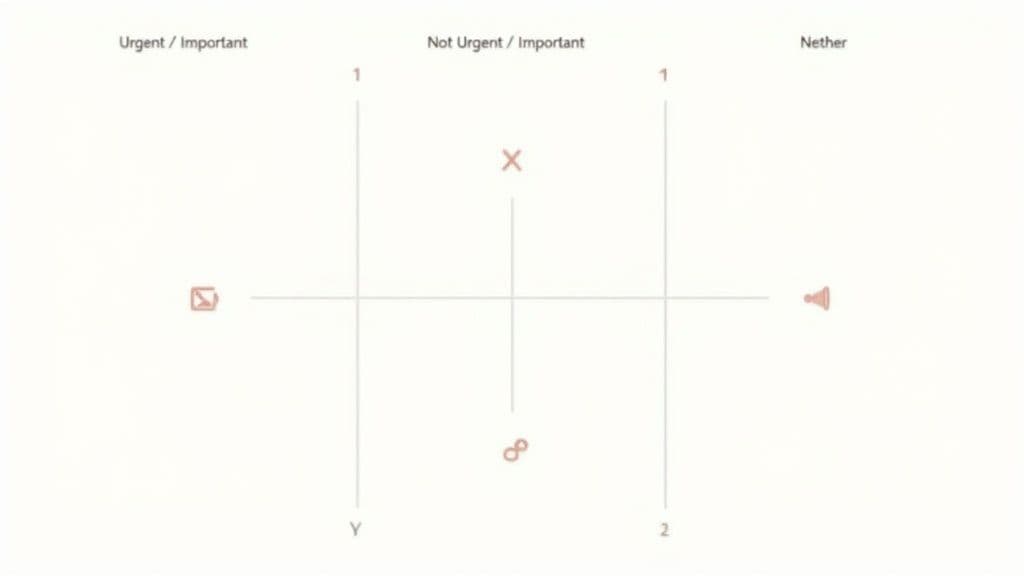Welcome to a year full of possibility. Turning ambition into reality takes more than willpower, it takes a reliable framework that fits the way you operate. This guide explains the most effective goal planning templates and how to choose one that matches your strengths and values. Where relevant, we note how numerology-style life path ideas can help you personalize a template, while acknowledging numerology is a belief system rather than a scientific method.
June 23, 2025 (5mo ago) — last updated October 29, 2025 (1mo ago)
Best Goal Planning Templates (Free + Premium)
Discover proven goal planning templates, free and premium, to clarify priorities, stay on track, and achieve measurable results.
← Back to blog
Best Goal Planning Templates (Free + Premium)
Summary: Discover proven goal planning templates, free and premium, to help you clarify priorities, stay on track, and achieve measurable results.
Introduction
Welcome to a year full of possibility. Turning ambition into reality takes more than willpower, it takes a reliable framework that fits the way you operate. This guide explains the most effective goal planning templates and how to choose one that matches your strengths and values. Where relevant, we note how numerology-style life path ideas can help you personalize a template, while acknowledging numerology is a belief system rather than a scientific method5.
We include practical implementation tips, digital tool suggestions, and links to templates you can use right away. Choose one framework, apply it to a single meaningful goal, and treat the process as an experiment in purposeful action.
Align Your Ambition: How to Choose a Goal Template for Your Unique Life Path
A good template removes ambiguity and makes the next steps obvious. Some people thrive with tight metrics and deadlines, others need reflective coaching prompts. Understanding your natural tendencies helps you pick a method that feels like an extension of who you are. Where useful, this guide pairs each template with suggestions for integrating personal values or life-path ideas so your goals feel motivating and sustainable.
Many frameworks translate well into digital tools like Notion, Todoist, or your favorite calendar and task manager. For hands-on integration, consider structured challenges such as the 7-day Notion challenge to build a system that fits your life.
1. SMART Goals Template: The Foundation of Actionable Planning
The SMART framework forces clarity by making goals Specific, Measurable, Achievable, Relevant, and Time-bound. Structured SMART templates guide you to define each element so a vague desire becomes a concrete plan. This approach is backed by decades of goal-setting research showing that specific, challenging goals improve performance and motivation1.
Example SMART goal: “I will meditate for 10 minutes each morning for the next 30 days to support my well-being.”
Numerology integration: Use the “Relevant” field to connect your goal to the themes of your life path, if that helps motivate you. For example, a Life Path 5 who craves variety might make the goal travel-related to increase relevance.
Implementation tips:
- Describe success in measurable terms, and clarify how you’ll track progress.
- Set realistic deadlines to create urgency without causing burnout.
- Store the template in a digital tool for easy updates and reminders.
2. OKR (Objectives and Key Results) Template: For Ambitious Stretch Goals
OKRs separate an inspirational Objective from 3–4 measurable Key Results that prove progress. Originating in tech and popularized by companies like Intel and Google, OKRs help teams and individuals pursue ambitious, breakthrough outcomes2.
Example: Objective: “Increase community impact.” Key Results: 1) Host three local events this quarter, 2) Grow mailing list to 1,000 subscribers, 3) Secure two new community partners.
Numerology integration: Align the Objective with your higher-purpose themes and use Key Results to keep the plan grounded.
Implementation tips:
- Limit objectives to 3–5 per cycle and measure outcomes, not tasks.
- Hold regular check-ins to adapt strategy and maintain momentum.
3. The 12 Week Year Template: A System for High-Velocity Achievement
The 12 Week Year treats 12 weeks as a planning year, creating a strong sense of urgency that boosts focus and execution. Short sprints help you get feedback quickly and adjust often, making it easier to build momentum and celebrate wins across the year4.
Example use cases: product launches, sales targets, fitness transformations.
Numerology integration: Align each 12-week sprint with the themes of your Personal Year Cycle to take advantage of seasonal energy shifts.
Implementation tips:
- Choose one to three critical goals per 12-week period.
- Track leading indicators weekly, and conduct non-negotiable weekly reviews.
4. Backwards Goal Planning Template: Deconstructing Your Ultimate Vision
Begin with the end in mind and map every milestone backward to today. This reverse-engineering approach reveals dependencies and prevents last-minute firefighting on complex, multi-stage goals.
Example: For a dissertation, start from the submission date and list final edits, data analysis, experiments, literature review, and proposal approval in reverse order.
Numerology integration: Use your ultimate life-purpose vision as the end point and trace the experiences needed to fulfill your path.
Implementation tips:
- Define a vivid end-state, then identify major milestones and break them into tasks.
- Build buffer time into each milestone to absorb delays.
5. Eisenhower Matrix Goal Template: The Art of Prioritization
The Eisenhower Matrix sorts tasks into four quadrants: Do (urgent, important), Decide (important, not urgent), Delegate (urgent, not important), and Delete (not urgent, not important). This visual tool prevents busywork from eclipsing work that truly moves you forward and has long been recommended for effective time management6.
Example: Reserve “Important, Not Urgent” time for strategic planning, skill development, or relationship-building.
Numerology integration: Let your life path guide what you place in the “Important” column so daily choices support long-term purpose.
Implementation tips:
- Regularly review and move tasks between quadrants as priorities change.
- Aim to spend most of your time on Important, Not Urgent activities.

6. GROW Model Template: A Framework for Insightful Coaching
GROW stands for Goal, Reality, Options, Way Forward. This coaching model helps you move beyond outcomes to explore current reality and possible pathways, building ownership and clarity along the way.
Example: For a promotion, define the Goal, assess Reality (skills and gaps), list Options (mentoring, training, networking), then commit to a Way Forward with deadlines and accountability.
Numerology integration: Use your Life Path to inform the “Reality” assessment and to brainstorm options that feel aligned with your values.
Implementation tips:
- Use open-ended questions in each stage to surface deeper motivations and barriers.
- Turn options into concrete actions with deadlines and accountability partners.
7. WOOP Method Template: Preparing Your Mind for Success
WOOP stands for Wish, Outcome, Obstacle, Plan. Research shows that mental contrasting with implementation intentions, the core of WOOP, increases the likelihood of achieving goals by making plans for real obstacles and linking them to if-then responses3.
Example: Wish: start a side business. Outcome: financial freedom and fulfillment. Obstacle: procrastination. Plan: “If I feel overwhelmed, then I will work for 25 minutes.”
Numerology integration: Identify shadow traits of your life path in the Obstacle step to create stronger if-then plans.
Implementation tips:
- Be brutally honest about internal obstacles.
- Use vivid mental imagery for both outcome and obstacle to strengthen the plan.
8. One Page Strategic Plan Template: Big Picture Clarity on a Single Page
A One Page Strategic Plan condenses vision, values, long-term goals, quarterly priorities, and action items into one document. This keeps the big picture visible and ensures daily work aligns with long-term aims.
Example: An entrepreneur maps quarterly revenue goals, key initiatives, and ownership of tasks on one sheet for easy visibility.
Numerology integration: Place core values and purpose in the center of the page to ensure alignment.
Implementation tips:
- Use concise, action-oriented language and review the plan quarterly.
- Post the plan where you see it daily to maintain focus.
Comparison at a Glance
| Template | Complexity | Resources | Best For | Key Advantage |
|---|---|---|---|---|
| SMART Goals | Low | Low | Beginner-friendly, measurable goals | Clarity and accountability |
| OKR | High | Medium–High | Ambitious, alignment-focused work | Drives stretch goals and transparency |
| 12 Week Year | Medium | Medium | Rapid execution, entrepreneurs | Creates urgency and focus |
| Backwards Planning | Medium–High | Medium | Complex projects | Reveals dependencies, reduces surprises |
| Eisenhower Matrix | Low | Low | Time management, overwhelmed professionals | Prioritizes what matters |
| GROW | Medium | Medium | Coaching, behavior change | Builds insight and commitment |
| WOOP | Low–Medium | Low | Habit change, mindset barriers | Prepares for obstacles with plans |
| One Page Plan | Medium | Medium | Strategic clarity for SMBs | Connects vision to daily action |
From Planning to Purposeful Living
The best system is the one you’ll use. Match a template to your natural style, then commit to one meaningful goal for a trial period. Integrate that template into a digital system, schedule regular reviews, and adjust as you learn.
For personalized alignment between templates and your deeper motivations, explore the Life Purpose App to see how life-path insights can help you select and adapt a planning framework.
Frequently Asked Questions
Q: Which template is best for beginners?
A: Start with SMART goals or the Eisenhower Matrix. Both are simple to implement and build a habit of clarity and prioritization.
Q: How do I pick one template for all my goals?
A: Choose based on goal type. Use OKRs for big, ambitious projects, WOOP for mindset or habit work, and Backwards Planning for complex, multi-step goals. You can combine elements across templates.
Q: How often should I review my plan?
A: Weekly check-ins are ideal for most templates. Use faster reviews (daily) for short sprints like the 12 Week Year, and quarterly reviews for strategic plans.
Discover Your Life Purpose Today!
Unlock your true potential and find your life’s purpose.
